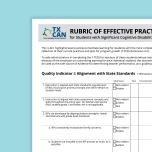December Checklist
By now, your classroom is hopefully running smoothly. You have schedules going. Everyone, from staff to students, has a clear understanding of how the day flows and the expectations have been determined. You know each student’s strengths and weaknesses and you have developed activities and routines that target weaknesses while drawing on strengths.
You know each student’s IEP goals and you have developed instruction to address the goals and methods of taking data on each goal. You continue to refine supports and materials to meet each student’s needs and you are always evaluating how your student can respond and shaping the response mode so that it is efficient for the student in conveying meaning and making choices.
However, if you are feeling like you are not where you want to be in one or two areas of your classroom, make use of the few weeks before break to do some real evaluation. What is working? What is not? Are there areas/strategies that need tweaking? Review your data and begin making some tentative plans for the remainder of the year. Use the coming break as a time to regroup, rethink and then start again with renewed vigor.
Review the Rubric of Effective Practices
Use the Rubric of Effective Practices below to guide you in evaluating your practices and classroom. Do you have additional ideas or need further clarification? Contact your regional ESC specialist or send them directly to ltomko@esc3.net.

Significant Cognitive Disabilities, Behavior, Instruction, ARD/IEP Supports, Inclusion
Rubric of Effective Practices for Students with Complex Access Needs
Collaboration
Carve out Time for Collaboration
When everyone understands what is expected of them and has the tools to do the job, work can be more productive and stress-free. A key feature of effective teams is collaboration. Classrooms are busy places, but if you can, carve out at least five minutes each day to connect to other staff, share information and provide feedback on student progress, you will save yourself time and effort in the long run. Remember that the paraprofessionals in your classroom need your guidance and respect. As a teacher of students with significant cognitive delays, your job can be overwhelming at times. A supportive staff is key to the overall success of the classroom, so consider setting up a resource center in your room where you can leave informative literature that will guide staff in supporting you and working with your students. In addition, just as you provide positive reinforcement to your students; remember to do the same for your staff (as well as related service providers). A teacher who has established a family culture in her classroom, where each team member and all students are valued and supported, is better equipped to meet the daily needs of the class.
Evaluate your Communication
The middle of the school year is a great time to evaluate the communication between yourself and your paraprofessionals. If you didn’t clearly express expectations at the beginning of the year, or if you feel that there are areas that you need to clarify, January is a good time to meet with your paraprofessionals to review what worked during the first half of the school year and revisit expectations for the remainder of the year.
Continue to Take Data
Finally, it always comes back to data. Remember to measure student progress or ask yourself, why is the student not making progress with the instruction? Collect data before break so that after break, you can see if any regression occurred. Regression of skills over breaks may indicate a need for extended school year services. ARD committees are required to consider ESY services and you will need data to support your recommendations.
Address Parent Questions or Concerns
Mid Year Update - You will be sending mid-year progress reports home to parents, but you may also want to consider sending home a feedback form for parents. This is a good opportunity, especially if you have many ARD/IEP meetings at the end of the school year, to find out about and address questions or concerns from parents before they become issues.
